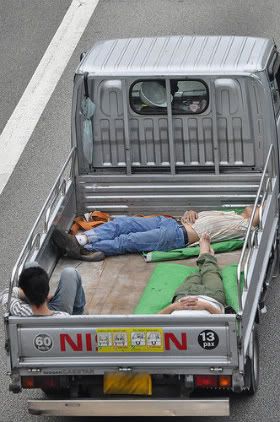Business Times

Travelling dangerously
THREE workers died, and 14 were injured, when the lorry they were travelling in skidded and overturned off the Pan-Island Expressway yesterday morning. So, with at least 17 people in the Toyota Dyna, there would have been more than a dozen men hanging on in the back of the open-top truck. Just another everyday sighting on Singapore’s highways.
Except that this particular trip did end tragically, with three lives lost. Accidents involving lorries plying workers – typically foreigners – in the cargo decks are hardly exceptional here. In fact, three of the four traffic accidents that the Singapore Civil Defence Force responded to yesterday morning alone involved lorries. In May 2009, four foreign workers were killed after the lorry they were in crashed into the back of a stationary trailer in Tuas.
Perhaps the casualty statistics – which easily run into the hundreds each year, if the unreported cases are included too – still are not grim enough; or because they involve mostly cheap imported work permit holders, not precious Singaporeans. But the question has been asked repeatedly in media coverage on the issue over the years – how many more lives have to be lost before something is done, once and for all, to ensure the safe transport of foreign workers?
A work group, led jointly by the Ministry of Manpower and the Land Transport Authority, spent more than a year looking into the issue in 2008 and 2009 – and came up merely with safety measures to be implemented over a few years. These include stipulations on higher side railings, canopies, and the amount of deck space per worker, plus “public education” on employers’ responsibilities. All of which, while enhancing safety, still do nothing about the fact that commuting unbelted in the back of an open-top truck is simply a fatality waiting to happen.
Plus, all the pre-existing rules on maximum passenger capacity and lorry speed limits have not banished overladen lorries or weaving speedsters from the roads. Of course, construction firms, contractors and other employers will raise a hue and cry over the most obvious solution of an outright ban on ferrying workers in open lorries – though some of the bigger companies do already ply workers in buses. The “key stakeholders’ interests” cited by the MOM-LTA review group boil down to costs.
But the government readily forked out $35 million towards the five-year plan for (otherwise unwilling) minibus operators to retro-fit their vehicles with seatbelts, following public outcry over the death of a young boy who was flung out of his school van. It’s a gross anomaly that first-world Singapore is so third-world in this respect; even Bahrain – not to mention the Western countries – has banned commuting in the back of open lorries despite howls of protest and prohibitive costs.
But as long as Singapore allows people to be transported atop an open truck, it is saying that foreign lives are not worth the cost and “trouble” of an unpopular measure.
—
Photo courtesy of Migrant Workers Singapore. This Business Times editorial was first published on 24 June 2010.

